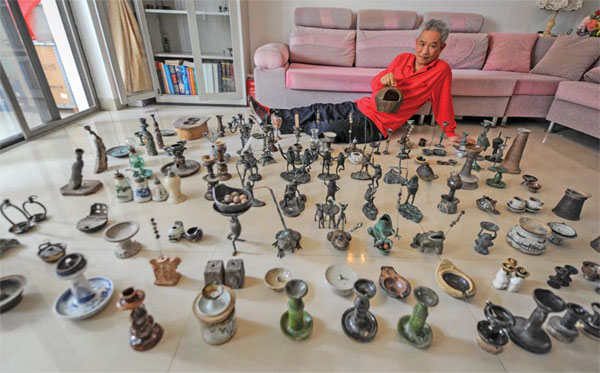Lamp collector lights up Hainan memories with fascinating collection gathered from far and wide
Most of us have various reasons for travel. It could be to enjoy beautiful scenery, relax, sample delicious food or even have an adventure. But Wang Fuhe is unique. The native of Hainan Island has made numerous trips searching for antique lamps.
As a son of a first-generation electricity worker, an occupation he followed, Wang has led a life full of stories about light and lamps in Hainan, the country's only tropical island province.
"When I was a boy, I enjoyed sitting by my father's legs, turning my head and listening to him telling stories about light and lamps," says Wang. The stories sowed the seeds of a love for lamps.

From left: A visitor displays two lamps. Deer-shaped lamps in Wang Fuhe's collection. The smallest lamp in Wang's collection. Photos by Yuan Chen / For China Daily

Wang Fuhe shows just a small sample of his collection that spans the centuries.
"Father collected the first lamp for the family when I was about 10 years old. Now I am in my 60s, and I have more than 1,000 lamps and lights in my house," says Wang.
In his 20-square-meter living room, Wang has placed more than 200 ancient lamps in glass showcases, on wooden shelves, on the walls and even on the ceiling, making his house more like a museum.
"All these lamps in front of your eyes, including the collections of the Warring States period (475-221 BC), kerosene lamps of various shapes and lamps lined up in the style of early last century, are the fruits of my efforts over the past 50 years," Wang says, naming the lamps as if they were part of his family - which, of course, they are.
"Look, this lamp is the most special and the only one left in China", he says, carefully taking out a lamp with an ancient ceramic texture from a showcase.
"It was a lamp that was usually hung on top of a boat by fishermen in the South China Sea. The lamp had to shine in wind and rain. It was very practically designed.
"Old objects from the South China Sea like this are rare. I saw it by chance one day in Haikou, capital of Hainan province. Experts at the Haikou Collection Association traced the lamp back to the Song Dynasty (420-479)," says Wang, a retired worker from the transformer substation of the Haikou Power Supply Bureau.
"This is Hainan's first electric light," he says with great pride.
In 1915, Haikou imported a diesel generator from the United Kingdom and installed an electric light at the generating house, the first electric light in Hainan. The light was abandoned when the company moved.
"What might the light look like, and how can I find it?" These were questions that Wang dealt with for years. One day, he got the much-desired object from an elderly collector.
He points out other fascinating examples. "This was passed on by my grandmother," Wang says, with deep affection, pointing to a tiny lamp that could be the smallest in the world, only about 5 centimeters high and 2 centimeters wide, depicting a Hainan fisherman.
"My grandma took the small lamp with her whenever she went to the sea for fishing, because she believed it was convenient to use and it was a mascot.

"Most people didn't store lamps in the past. So I could easily get a favorite lamp from a friend after a meal or just give them a bag of rice," Wang says while recalling how he got some of the lamps in his collection.
However, he has needed help to fund his ambition. "Collecting them is not always easy, and Wang has spent much of the family savings," says Wang's wife, Chen Jixin, a retired librarian. "It is a good thing to do, so I support him."
To Wang, collecting the lamps is actually passing on Hainan's tradition.
Last year, he wrote a book titled The Culture of Lamps and Electricity, in which he tells stories about his treasures - the Qiongya begonia lamps, the oil lamps and the lamp culture along the Silk Road.
Qiongya begonia lamps have a special historical and cultural value for Hainan, because from the popular and artistic frog-shaped lamp holders, we can see how Hainan people in ancient times studied the frogs. It also shows their technical know-how, since they used the oil of dried fruits for lighting.
"Both the flowers and oil of begonia trees give out a light fragrance when lit," says Wang. "This helps to fight the growth of moss on the walls and prevent insects."
The large number of such lamps shows how popular they used to be and how fragrant the island was with begonia flowers blossoming in many areas on the island, he says.
Energy-saving lamps were made during the Tang Dynasty (618-907), an invention that coincided with the "green concept" of the moment, Wang adds. "I get great pleasure learning about history and people's lives from a collection."
Whom will Wang pass the great treasure of antique lamps to?
"My house is only a temporary stay for the lamps, not their final destination," he says.
"My biggest concern for the time being is to find a safe place for them and let more people know about them and learn more about the culture of light in Hainan."
Although many people collect things in the hope that their collections will one day fetch a good price, Wang says he "will never sell the ancient lamps, for whatever reason".
"I don't care that people will say I am foolish. I am only worried that the culture of Hainan light will be forgotten one day.
"I would like to donate all my collections, especially the South China Sea fishing lamp, the one that I cherish most, to the newly completed South China Sea Museum, which will open soon to the public," says Wang.
If not, he hopes all of his ancient lamps will find organizations or people who will care for them. "It is of great satisfaction to me to see that many people can appreciate my collection," Wang says, adding that the lamps are the fruits of wisdom of old generations and must not be lost.
mazhiping@chinadaily.com.cn
(China Daily Africa Weekly 04/14/2017 page21)